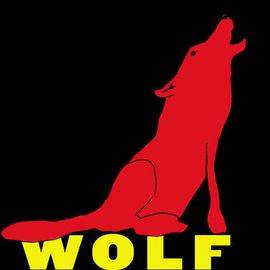When theatre is good, it has the ability to make you sit up straighter in your chair. When theatre is very good, it can make you question an opinion you’ve held for too long or appreciate someone or something that you’ve taken for granted. When theatre is created by someone like Deke Weaver, it can make you forget you’re in a chair at all, that you’re in a room with other people, that you’ve ever seen a play before.
And thank merciful heavens, Deke Weaver has a new play.
A press release from Jennifer Allen, Weaver’s partner, states:
WOLF is the third performance in Weaver’s life-long project, The Unreliable Bestiary. The project is presenting a performance for every letter of the alphabet, each letter representing a particular endangered animal. The audaciously ambitious gesture of creating 26 individual, full-length performances will present a tiny sliver of our current catastrophic loss of habitat and biodiversity. MONKEY, The Bestiary’s first performance, opened in a black box theater on Darwin’s 200th birthday. Other events will take place in unusual sites related to the particular animal. 2010’s ELEPHANT premiered in the University of Illinois Stock Pavilion, a cavernous arena chosen for its associations with circuses, state fairs, and Roman amphitheatre battles. A traveling version was presented at the 2011 Sundance Film Festival. If ELEPHANT felt like a circus, WOLF might feel like a campfire.
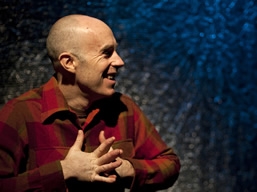
If there’s anyone I’d like to have telling me a campfire story, it’s Deke Weaver. I first saw his particular brand of genius in the aforementioned black box theater, The Station Theatre, when he presented the original work The Crimes and Confessions of Kip Knutsen, a wry and affecting yarn about small-town life and ice hockey. The play had the shape and sound of what you might expect to find in a small theater, but there was something about it — something intangible but immediately recognizable — that elevated it. This quality lifted the play out of the realm of “one-man show” or “local author,” and it lifted the audience out of their damn seats. Weaver’s facility with beautiful language and his ability to convey those words with both intelligent acting and clever staging made me an instant fan of his work.
When Weaver returned to the Station the following season with MONKEY, I had huge expectations, and they were pretty much smooshed into a ball and tossed over my shoulder as I walked into the lobby. The play hadn’t even begun, and I was already impressed. From the jungle motif of the lobby to the unspeaking, monkey-mask-wearing box office attendants, the play already had a lot going for it. Upon entering the theater proper, to find Mr. Weaver dressed in monkey attire and scratching the names of engendered primates on a chalkboard, it was clear that the experience of the play would be not only creative and challenging, but also immersive.
By the end of the night, having watched, listened to, and engaged with Weaver, his sound engineering, his multimedia visuals, his partner Jennifer Allen’s choreography… Well, I wasn’t quite the same. And that’s the highest compliment I can pay a performance of live theatre.
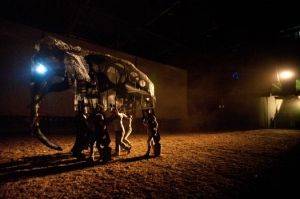
I will forever regret that I missed Weaver’s next show, the installation-slash-play ELEPHANT. I will forever regret it because I keep hearing things about it like the things I heard at dinner last night. While catching up with some friends last night, the conversation turned to theatre, as it always does. When Deke Weaver’s name came up, a friend spoke of how, at a performance of ELEPHANT, her breath was literally taken away when, in a climactic moment, a huge elephant puppet, controlled from within by performers, appeared to the amazement of the assembled crowd. She looked across the table at me, her eyes still wide with wonder even after all this time. And that, friends, is the second highest compliment I can pay a performance of live theatre.
With his newest performance art/theatre piece WOLF about to open, I was pleased to reach out to Weaver and Allen for some information about the inspiration for the new work, the shape this piece will take, and the journey the audience will have to take to see it.
********
[Cue wolves howling…]
SP: I know each of your Unreliable Bestiary performances represents both an endangered species and a letter of the alphabet, but you’re obviously not going in alphabetical order. How do you decide which animal/letter comes next?
For the start of the Bestiary I’m sticking with animals that some folks call “charismatic megafauna.” These are the animals that are the stars in our fairy tales, cartoons, zoos, and national parks. Usually big, usually mammals, usually part of a long history in our human imaginations. People tend to empathize more with these sorts of animals because we have a lot in common with these particular creatures – family life, play, fear, etc. Maybe more in common with these animals than what you might see (at first) with snakes and reptiles. Monkeys, elephants and wolves are very common in myths around the world – they seemed like a good place to start.
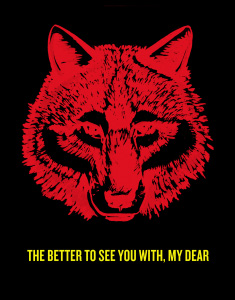 Each of your Bestiary pieces takes on a different style, a different means of delivery…. Do you go into each production with a format in mind? Sort of “This time I’d like to try this kind of play…”
Each of your Bestiary pieces takes on a different style, a different means of delivery…. Do you go into each production with a format in mind? Sort of “This time I’d like to try this kind of play…”
One of the ideas of the Bestiary is to have the site of the performance reflect aspects of the animal and the stories around the animal. MONKEY was at the Station Theater, but ELEPHANT and WOLF were not in traditional black-box theaters. For ELEPHANT we wanted the scale of the space to reflect the size of the animal – so we went for the U of I’s Stock Pavilion. The Stock Pavilion’s size and quality allowed for multiple associations: domestic livestock (in Thailand elephants are classified as livestock, just like cattle and horses here), Roman amphitheater battles (where elephants were featured) and most obviosuly, circuses. For WOLF we’re playing with a mix of things: all the fairy-tale associations of a wolf in the forest, the culture of wildlife management (national parks, rangers). Like the press materials say, If ELEPHANT was the circus, WOLF will be the story told around a campfire. It’s more intimate.
After the most recent Pecha Kucha, someone asked me why we didn’t do more shows of ELEPHANT. I think the same question might come up about WOLF. We’d love to. Unfortunately, these shows cost a lot of money. I’ve done a lot of fundraising but doubling the number of shows doubles the cost (renting the buses, the Barn, the projectors and paying for the artists time). And they take a lot of time to prepare. Nobody in the group that’s making this show is doing it as a full-time gig – but it becomes a full-time thing when it’s up and running. It’s important to me to keep these shows free. I like paying artists for their time. Renting good gear is important and is absolutely not cheap.
 Some folks might get turned away from WOLF. Wallace Shawn and Andre Gregory did a show a couple of years ago. It had a very limited run – a month, down in an oldsteambath/men’s club in Wall Street. And for each show there were only 35 seats. If you didn’t get in, you didn’t get in. The intimacy was crucial to the show and they weren’t willing to sacrifice that. We want that intimacy for WOLF.
Some folks might get turned away from WOLF. Wallace Shawn and Andre Gregory did a show a couple of years ago. It had a very limited run – a month, down in an oldsteambath/men’s club in Wall Street. And for each show there were only 35 seats. If you didn’t get in, you didn’t get in. The intimacy was crucial to the show and they weren’t willing to sacrifice that. We want that intimacy for WOLF.
But, of course, I want people to see the work. If we could afford a longer run we’d do it. With that being said, we’re working with Shatterglass Studios to shoot strong documentation of WOLF. These guys did a great job with ELEPHANT, I just finished editing it, and we’d like to show it sometime in the next couple of months. So, that’s one way of giving these Bestiary shows longer lives — making strong DVD’s, doing screenings. Another way is making smaller one-man versions of the shows that are part-monolog, part cinematic video — a version that is easily transportable. I could do it in a classroom, somebody’s living room, a film festival or a traditional theater. Obviously both the DVD and the solo versions are going to be wildly different than the big site-specific event, but I think that’s okay–to have different interpretations of the thing.
How much has WOLF evolved, since its inception? Is it, at this point, what you set out to do?
Well, it’s hard to say. Originally we wanted to do the show a year ago. Both Jennifer and I are happy we put it off for a year. ELEPHANT burned us both out. Neither one of us had done anything that big, and it took its toll. The extra year let me spend some more time fundraising, and working kinks out. WOLF could probably use some more time in development — but it’s harder to do in a place like CU, where you don’t have tiny theater spaces with work-in-progress showing opportunities. The other thing the extra year allowed me to do was to go up to Isle Royale. I was an artist-in-residence at the national park a year ago. For the past 60 years, this big island has been the home of a famous predator-prey (wolf-moose) study. My research over the past three years has also included a Wolf Management workshop in Yellowstone and a lot of reading. Jennifer and I have visited wolf sanctuaries in Oregon, Idaho and Minnesota.

We find a site for the show, and the site determines a lot. We went to the Music Festival at the Barn in Allerton 2 years ago, and fell in love with both the Barn and the idea of using the trails and forest of Allerton for WOLF. Then we set a date. Jennifer, Chris Peck (our sound/composer who is based in Virginia) and I had acouple of days in December 2012 where we talked about the research I’d been doing and our wolf travels. We listened to what I’d been writing, and then responded to that writing in different ways – sound, movement, video. We talked about the big overarching structure as well as images and various visual ideas. I spent the spring getting the script into shape. The rehearsals increased — Jen spending lots of time with available dancers — and we started integrating some of the monologs, characters, choreography, and visual ideas into a few work-in-progress showings (a few here in town, a couple of nights up in Minneapolis, and one in New York).
I think we’re coming close to the original goal of the piece, but it’s hard to fully see it until all the elements (script, lighting, video, sound, choreography, set, costume, etc. etc.) come together. But it is coming together…right now.
It occurs to me that I’ve enjoyed your work a lot but I know very little about you. Which might, of course, be by design… How did you come to do this type of work? How did you decide this was your medium?
No, definitely not by design. Like Kip in the Kip Knutzen show, it’s been drilled into me that you shouldn’t showboat. Showboating will kill you. Lightning will strike you down.
I grew up outside Minneapolis. Went to undergrad in Maine (double major biology and studio art), grad school (MFA in photography) at University of Colorado, Boulder. Lived in San Francisco for 10 years. Then NYC for 6 years, where I met Jennifer Allen. She lived there for 17 years working as a professional dancer and choreographer. We moved here in 2005. I teach in U of I’s School of Art & Design New Media Department. Jennifer’s built a bodywork practice that includes a couple of different modalities.
Early in my grad work at Boulder, I realized that what I was really interested in was storytelling. One of my first classes at Boulder was about performance art. I loved it. It blew me away. It seemed to encompass all these ideas I had — visual, aural, rhythmic ideas that were whole experiences … finding ways of transforming space and time — the best live performance can change people.
Most of my work has been as a solo writer-performer and video-maker. However, ELEPHANT and WOLF have both been much larger productions then a solo monolog. Both productions have involved a LOT of collaboration and a lot more people. The sharing of the direction of the work ebbs and flows as the individual productions develop. Jayne Wenger, a director of mine from San Francisco, reconnected with me for some dramaturgical work. As we get closer to the show date, Jennifer becomes more of the director and outside eye as I become more focused on my own performance and the editing/animating of the video projections.
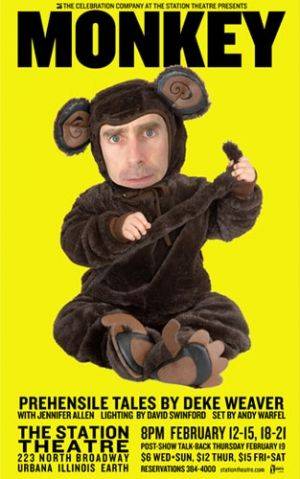
Just to reveal the scope of the cast and crew involved, I’ll mention them all: Jen has been working with two dancers, Jessica Cornish and Laura Chiaramonte all summer.The rest of our dancers (Niall Jones, Angie Pittman, Nico Brown) are MFAs in the Dance Dept and got plugged in after dancing all around the world this summer. We kept in touch with Chris Peck through Skype, but he’s been back for a week now. Aaron Landsman, Beth Simpson and David Hays have been rangers-in-training. The rest of our design team — Valerie Oliveiro (lighting design), Grant Bowen (set design) and Susan Becker (costume) have been working their tails off. Susan has a small village sewing fur on costumes. Nicki Werner and Maria Lux have made an amazing installation that’s part of the experience in the barn. They motivated another small village of generous artists for building, painting and gluing.
As with any crew of folk, there are shifts – Andy Warfel (design collaborator on MONKEY and ELEPHANT) moved away. Val Oliveiro just moved up to Minneapolis and Grant moved to Philadelphia. All of this is a little sad, because when you find people you trust, you want to keep working with them. But I guess I want to say how hard people are working on this show. It’s a big generous group.
You don’t have to tell me which animal comes next, but I’ll ask: Do you know already?
I’m thinking of doing Lions and Tigers and Bears as a rep thing, a different monolog each night. Ideally it would be staged in a cage in an abandoned zoo…but I don’t know if abandoned zoos exist. So we’ll see.
********
As is the case with any production presented by Weaver, Allen, and their merry band, space is going to be limited and the run way too short. And what should the audience expect…? Let’s go back to the press release:
WOLF’s dizzy three-legged, one-of-a-kind journey will start in Urbana with a bus ride through the cornfields to Allerton Park and Conference Center, a small old-growth forest. On the bus, “park rangers” (actors) will present a talk about reintroducing wolves to Illinois (a state that has very little wild land). The second leg of the performance will lead the audience through the forest, carefully watching the landscape for wolves. Finally, after traveling over the river and through the woods, the audience arrives at “Grandmother’s House” – a barn filled with video, dance, live music, and stories that pull some of the threads together. WOLF will sink its teeth into the history, science, and myth of this remarkable creature, while putting a domestic finger on the pulse of our uneasy relationship with the wild.
The performance is free, but there will be very limited seating. Tickets will be available at 5:30 p.m. each performance day on a first-come-first-served basis. To reserve seats, see the Rangers near the buses in front of the Krannert Center. And please keep in mind that this theatre experience requires some outdoorsiness, so dress for the weather and wear comfortable shoes for walking on dirt trails in the woods. Following the show, the buses return to Krannert Center about 9:30 p.m. For more information, visit unreliablebestiary.org.
As someone who has been deeply affected by their work in the past, it’s hard for me not to be overly dramatic when anticipating what the result of the experience might be for audience members, but I’ll do my very best: Go see this. It will probably change your life.
[Cue wolves howling again. Just for effect.]








